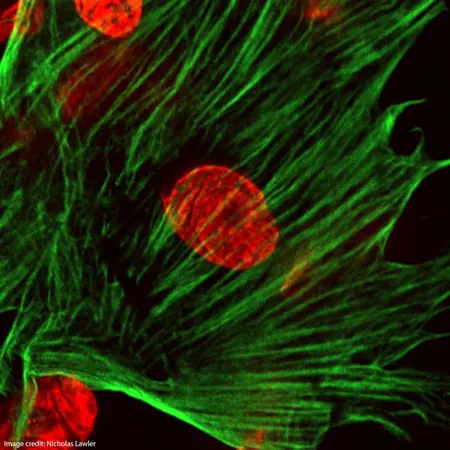
Revolutionary AI Paves the Way for Drug Discovery by Analyzing Cell Images for Genetic Changes
2025-05-13
Author: Sarah
Unlocking New Possibilities in Medicine
Scientists at the Paul Scherrer Institute (PSI) have unveiled a groundbreaking artificial intelligence (AI) tool that could be a game-changer in drug discovery. This innovative approach focuses on identifying genetic perturbations through cell images, promising a more efficient and cost-effective method for uncovering potential new treatments.
The Challenge: Understanding Complex Diseases
Modern medicine is shifting towards early detection and targeted manipulation of genes related to diseases. This is especially crucial in complex conditions like cancer, Alzheimer's, and chronic inflammatory diseases. The major hurdle lies not only in pinpointing individual genes, but also in comprehending the intricate regulatory networks that govern them, highlighting the importance of the three-dimensional DNA structure known as chromatin.
A Breakthrough Approach: Meet Image2Reg
Led by prominent researchers G.V. Shivashankar and Caroline Uhler, the team has developed an AI system called Image2Reg (Image to Regulation). This system aims to streamline the identification of genetic changes using simple microscopic images from cell nuclei—without the need for costly sequencing methods.
How It Works: A Fusion of Imaging and AI
Image2Reg leverages the notion that when a gene's activity is disrupted, the appearance of chromatin is subtly altered. The team trained a convolutional neural network (CNN) to detect these patterns, enabling the AI to recognize the changes in chromatin images caused by gene activity.
Simultaneously, Image2Reg constructs a biological network for the specific cell type, detailing how genes interact through established molecular biology principles, including protein interactions and collective gene expression data.
Building a Mathematical Model of Gene Functionality
The insights gathered are synthesized into a mathematical model that captures the interconnections among genes, effectively creating a 'rule book' for the cell. This model maps out which genes collaborate, regulate each other, and participate in signaling pathways, irrespective of their visual representation in images.
Impressive Accuracy in Predictions
The researchers trained their AI on nearly a million single-cell images, achieving an accuracy of 26% in identifying altered genes from images alone. This is a significant leap, as the probability of guessing correctly by chance stands at merely 2%. This success indicates that recognizable patterns in cell structure correlate with specific genes.
A New Tool for Diagnosing and Treating Diseases
Though still in development, Image2Reg harbors vast potential for practical applications. The researchers envision it aiding in the identification of genes affected by diseases like cancer or Alzheimer's—without intricate experimental procedures. This could lead to earlier disease detection, potentially before symptoms arise.
Looking Ahead: A Start-Up's Aspirations
With their innovative findings, the researchers are eager to establish a start-up aimed at developing treatments for fibrosis, a currently incurable condition that replaces functional tissue with scar-like tissue, hampering organ function. The future of drug discovery may very well rely on the unique insights provided by Image2Reg.
Conclusion: Bridging the Gap Between Biology and Medicine
As the advent of AI continues to reshape healthcare, Image2Reg exemplifies the fusion of technology with biological understanding. This revolutionary tool stands to transform the landscape of drug discovery and disease diagnosis, heralding a new era of medical advancements.


 Brasil (PT)
Brasil (PT)
 Canada (EN)
Canada (EN)
 Chile (ES)
Chile (ES)
 Česko (CS)
Česko (CS)
 대한민국 (KO)
대한민국 (KO)
 España (ES)
España (ES)
 France (FR)
France (FR)
 Hong Kong (EN)
Hong Kong (EN)
 Italia (IT)
Italia (IT)
 日本 (JA)
日本 (JA)
 Magyarország (HU)
Magyarország (HU)
 Norge (NO)
Norge (NO)
 Polska (PL)
Polska (PL)
 Schweiz (DE)
Schweiz (DE)
 Singapore (EN)
Singapore (EN)
 Sverige (SV)
Sverige (SV)
 Suomi (FI)
Suomi (FI)
 Türkiye (TR)
Türkiye (TR)
 الإمارات العربية المتحدة (AR)
الإمارات العربية المتحدة (AR)